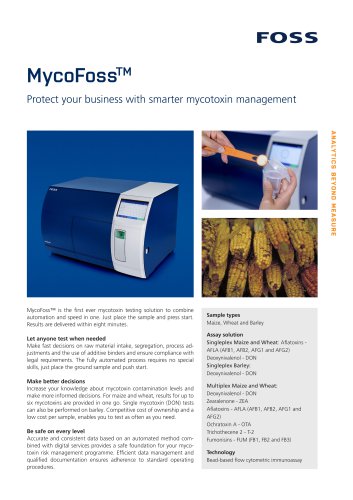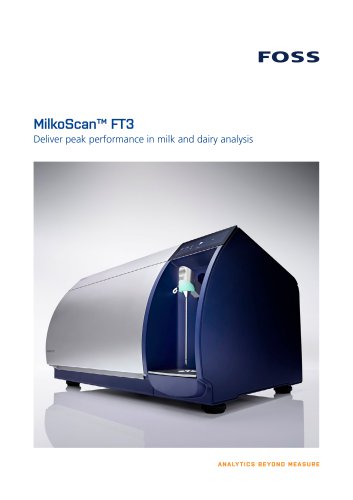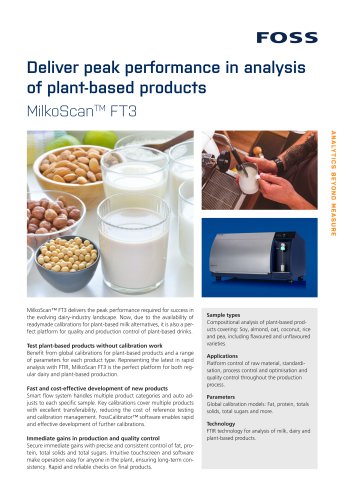
Catalog excerpts
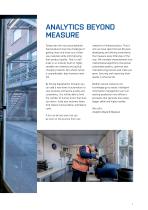
Today even the most accomplished feed producers face the challenge of getting more and more out of their raw materials while still improving their product quality. That is a tall order in an industry built on highly variable raw materials and quickly changing markets. But where nature is unpredictable, data harvests never fail. material to finished product. That is why we have spent the last 60 years developing and refining instruments that measure every little step of the way. We translate measurements into mathematical algorithms that power automated systems, optimise your manufacturing...
Open the catalog to page 3
TAKE CONTROL OF RAW MATERIALS FOR IMPROVED PROFIT Another delivery draws up to the weighbridge. You know that your decision on how to handle it will impact profitability downstream in the process, yet you are not always free to make the ideal move. You might be receiving poor quality raw materials without knowing it because it’s not possible to test each and every delivery. This can lead to variation in the composition of your raw material and will demand a higher safety margin to meet specifications. Plus, there’s a risk of lower pellet quality as well as the risk of fines and low storage...
Open the catalog to page 4
Reduce variability with rapid analysis at the weighbridge But the inevitable variability in deliveries need not be all bad news. While some shipments will be below others will be above specifications. Understanding the variation and identifying individual shipments that are out of spec will improve your profitability. Ingredients receival is a perfect control point for monitoring this variation based on rules and targets. The ability to measure more samples with rapid and convenient analysis will give you enhanced monitoring of your key ingredients. Just one simple test in less than one...
Open the catalog to page 5
PRODUCE CLOSER TO SPECIFICATIONS TO PREVENT PROTEIN GIVEAWAY How can you produce close to specification when the cost and quality of your raw material is always changing? It is a common challenge in feed production, yet the analytical tools are available to help you remain agile. For instance, you can switch between raw materials based on price, availability and actual nutrient content. You can also move your moisture target closer to specification to avoid protein give-away to boost revenue per production line without increasing raw material costs or compromising quality. By using FOSS NIR...
Open the catalog to page 6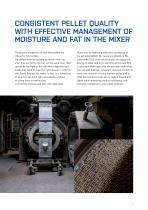
CONSISTENT PELLET QUALITY WITH EFFECTIVE MANAGEMENT OF MOISTURE AND FAT IN THE MIXER The physical properties of your feed pellets are critical for fish farmers. The pellets must be durable to remain intact up until they are fed to the fish. At the same time, they cannot be too hard as this will affect digestion and finally they need to have the right density in order to sink slowly through the water. In fact, it is something of an art to get them right consistently without incurring fines or raising costs. Controlling moisture and fat in the feed mash allows you to improve quality and...
Open the catalog to page 7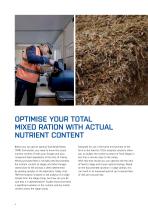
OPTIMISE YOUR TOTAL MIXED RATION WITH ACTUAL NUTRIENT CONTENT Before you can get an optimal Total Mixed Ratio (TMR) formulation, you need to know the actual nutrient content of both your forages and your compound feed ingredients at the time of mixing. While purchased feed is normally well documented, the nutrient content of silages and other forages stored close to the animals is often determined by sending samples to the laboratory. Today most TMR formulation is based on lab analysis of a single sample from the silage clamp, but how can you be sure that it is representative? Studies show...
Open the catalog to page 8
NETWORKING FOR MORE PROFITABLE USE OF FEED INGREDIENTS The use of feed additives and speciality micro ingredients allows you to get more value from costly raw materials. Today, most suppliers of feed additives and micro ingredients use NIR analysis of feed and raw materials to determine special ingredients such as amino acids and how to use them. And FOSS can help you to work more effectively with not just a few suppliers but a whole range. FOSS solutions are approved by all the major global ingredient providers and a growing number use FOSS networking solutions to connect to their...
Open the catalog to page 9
TECHNOLOGY OVERVIEW Near infrared analysis Near infrared in the process FOSS NIR solutions provide analysis of feed with exceptional accuracy. Feed quality control often involves handling a variety of samples, from powder to whole grain and pellets. Near Infrared can also be applied directly in the process flow with the ProFoss™ analyser. For instance, in feed milling, the ProFoss can be mounted directly in the process where it measures moisture and protein in feed mash every few seconds for optimal and consistent pellet quality. The results are fed back to a computer in the mill control...
Open the catalog to page 10
Automated laboratory methods Digital connectivity Standard tests such as crude fibre are not always the most convenient tests to perform, but are nonetheless essential for reference and labelling purposes. FossManager™ empowers you to manage analytical instruments directly from your PC while FossAssure™ Pro helps you to ensure accuracy and uptime. FOSS automated laboratory solutions include innovative features designed to make procedures as fast, cost-effective and safe as possible while reducing the risk of human error. With the Fibertec™ 8000, samples are handled separately in standard...
Open the catalog to page 11
FOSS Foss Allé 1 DK-3400 Hilleroed Denmark Tel.: +45 7010 3370 info@foss.dk November 2018. GB
Open the catalog to page 12All FOSS catalogs and technical brochures
-
Infratec™
2 Pages
-
OIL PROCESSING SOLUTIONS
8 Pages
-
FEED SOLUTIONS
4 Pages
-
MycoFoss™
12 Pages
-
MycoFoss™ Datasheet
2 Pages
-
MilkoScan™ Mars
2 Pages
-
NIRS™ DS3 Dairy Analyser
2 Pages
-
FoodScan™ 2 Dairy
2 Pages
-
CombiFoss™ 7
4 Pages
-
BacSomatic™
2 Pages
-
MilkoScan™ FT3 Brochure
12 Pages
-
MilkoScanTM FT1
2 Pages
-
PROFOSS™ 2 MILK STANDARDIZATION
12 Pages
-
FOSS IN DAIRY
16 Pages
Archived catalogs
-
MilkoScan™ FT3 Specification
2 Pages
-
MilkoScanTM FT3
2 Pages








